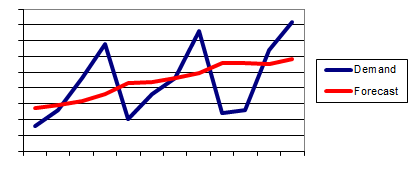

Last month UpDoc Media launched our consulting service, Business Renovations. Marking this occasion, we are pleased to share about some our trade secrets and strategic frameworks which we use to tune up businesses for more value, more growth, and more profit. And so, for the entire month of October, we will be dedicating a very special blog series to your success by making available some of the best tools out there in optimizing business. Since we’re approaching the holidays, we will be kicking off this special blog series with…!
5 Steps to Managing Seasonal Demand
October is here which means the holidays draw near. For many of us, this is a time we look forward to for relaxation, rejuvenation, and some well deserved time off. Translate that thought to a manager and they hear this: “STAFFING NIGHTMARE!” which is really a Supply Chain nightmare.
Come the various holidays, there is a sudden seasonal flux in both consumer demand as well as industry demand for resources. Various business models use different solutions which may include a per diem pool, staffing through an agency, hiring seasonal labor, and reinforcing their supply chain in terms of ordering point and safety inventory levels for resources as well as finished products.
Whatever that strategy is, it is absolutely critical that managers accurately forecast and manage their seasonal demand. Guess work could mean too little staff or too little product available to the customers. Or, it could be that they prepare for too much, wasting precious resources. With too little preparation, businesses lose market share and may possibly lose customers permanently. Being over prepared, a business may accumulate so much cost in production (and manpower) that you end up losing any profit margins you could have had for that season — or worse — end up losing money all together.
Accuracy is the name of the game when to comes to forecasting demand and it is here we begin with our five steps to managing seasonal demand.
1. Organize your data.
In order to forecast seasonal needs, you must have data on what has happened in the past and for what time frames. For most industries, a month by month report on what your demand and supply chain needs is sufficient to create an accurate forecast. However, managers must ensure their data includes the demand a firm has for their own suppliers, the orders of their customers, and, the material needs directly have associated with those time frames. Now, if seasonal demand is a concern that you have just become aware of and you have no supporting data, fear not! There are many creative ways for businesses to back track their information. If you do not have direct sales data, you can go by staffing, resource utilization, and your own orders from your suppliers to serve as a hint to what your past demand actually looked like.
2. Trend your data.
There are various techniques to processing your data for seasonal trends. One of such techniques is to deseasonalize the data so you get a clear trend of your business needs. Graphically, it looks like this:
Instead of having running up and down hills, you get a smooth picture of how much you’re growing for your forecast. This allows for managers to have a more accurate feel for the big picture of what they need which could include human resources, machinery, and other resources in their plans going forward. This forecast then becomes a mathematical and accurate approach to the season to come.
3. Increase your safety inventory.
During times of seasonal demand, it is quite easy for the market to sway in extreme ways. This means it could be that customers suddenly flood to your doors for a specific product in waves which you’ve never seen before. And, it is a good problem to have. Yet, it will be a terrible problem if your business did not have the desired product on hand or staff to provide the desired service. An example is seen in the clinical setting: a firm wants the right amount of clinicians for the amount of patients wanting to be seen. The worst case here would be having a shortage of clinicians which could cause a massive backup, leading to a waiting list or having those patients then going down the street to see your competitor instead.
4. Communicate frequently with your partners.
It is a good thing to be in very frequent contact with your upstream and downstream partners as they may be able to give you hints as to what is coming down the pipe. In the same vein, you will also be able to inform your downstream partners of any trending to help them succeed. After all, you’re all part of the same value chain which means each firm builds on the success of the next. What this also entails is keeping some tabs on some otherwise friendly substitutes and competitors. In times of demand flux, it is nice to know that a common goal can serve even the most staunch rivals in a mutually beneficial way. Therefore, make sure that in addition to rebuffing your per diem staff, holding more inventory, and deepening your resource pools — that you also keep your competitors close enough to handle some mutual demand during extra busy times. I’ve known several businesses that have benefited immensely from this type of seasonal alliance and have now made the arrangement permanent.
5. Schedule early and offer excellent rates.
Whatever resources you will need, be it human, capital, material, etc., make sure you schedule for these very early. Base these scheduling needs on the forecast and be sure to offer excellent rates for the availability. After all, the worst case for businesses is to miss the opportunity of seasonal demand increase. For many businesses, they rely on the revenue from seasonal demand to pull through the slow times of the year. Missing this boat can make life very hard for some businesses and can even cause some firms to fold. For others, it is basically giving up free money by losing orders and losing customers. Having resources available requires that you secure those schedules (be it staffing or resource procurement) and offer extra attractive rates for those times to ensure their commitment. If you require a lot of material resources, make sure you either have them ordered early and stored for inventory. If this isn’t an option, up your weekly or monthly orders just before the demand season starts so that you can have the safety inventory loaded as part of your regular ordering cycle.
Managing seasonal demand can be awesome or terrible. Businesses that have dialed in a system enjoy the benefit of sudden surges in revenue, profits, and new customer acquisitions. Businesses who have ill prepared for such times tend to lose out on these opportunities and can even lose long term business partners and customers. So, follow these five steps on your path toward success in the coming season!
If you have any questions or want to learn more about optimizing your business, we are here to help!










